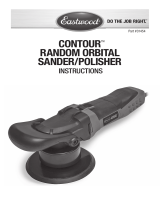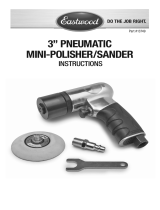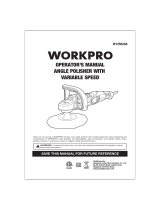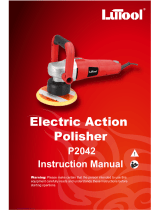Page is loading ...

VARIABLE SPEED 6" ORBITAL
BUFFER/POLISHER
INSTRUCTIONS
Part #32489

2 Eastwood Technical Assistance: 800.343.9353 >> tech@eastwood.com
The
EASTWOOD VARIABLE SPEED 6" ORBITAL BUFFER/POLISHER
is built to high quality
standards to provide long life and smooth operation to serve the demands of the avid hobbyist
and seasoned professional alike.
Compact and well balanced for fatigue free use with a choice of handle types for maximum
user comfort. Features a soft-start response to minimize polish spatter and an accurate,
electronic variable speed control to help avoid paint surface damage or burn-through.
The spindle accepts all 6” accessory pads with 5/16”-24 male threads.
INCLUDES
(1) Orbital Buffer/Polisher Tool
(1) Auxiliary Side Handle
(1) “D” Handle
(1) 6” Hook and Loop
Backing Pad
(1) 6” Hook and Loop
Foam Polishing Pad
(2) M8 Socket Head Screws
(1) 5mm Hex Key
(1) Arbor Flat Wrench
(2) Replacement Motor Brushes
SPECIFICATIONS
Power Requirements: 120 Volts AC, 60Hz, 7.5 Amps
Arbor Size: 5/16”-24 female thread
Replacement
Buffing/Polishing Disk Size & Type: 6” Hook & Loop [152mm], min. 6,400 RPM rating,
5/16”-24 male thread
Soft-Start Motor Startup
Motor Speed; Variable: 2000 to 6400 RPM
Orbit Size: 9mm
Power Cord: 16 Ga., Length = 10’

To order parts and supplies: 800.343.9353 >> eastwood.com 3
DANGER indicates a hazardous situation which, if not avoided, will result in death or serious injury.
WARNING indicates a hazardous situation which, if not avoided, could result in death or serious injury.
CAUTION used with the safety alert symbol, indicates a hazardous situation which, if not avoided,
could result in minor or moderate injury.
NOTICE is used to address practices not related to personal injury.
GENERAL SAFETY RULES
Read all instructions. Failure to follow all instructions listed below may result in electric shock,
fire and/or serious injury. The term "power tool" in all of the warnings listed below refers to your
mains-operated (corded) power tool or battery-operated (cordless) power tool.
SAVE THESE INSTRUCTIONS
1) WORK AREA SAFETY
a) Keep work area clean and well lit. Cluttered or dark areas invite accidents.
b) Do not operate power tools in explosive atmospheres, such as in the presence of flammable
liquids, gases or dust. Power tools create sparks which may ignite the dust or fumes.
c) Keep children and bystanders away while operating a power tool. Distractions can cause you
to lose control.
SAFETY INFORMATION

4 Eastwood Technical Assistance: 800.343.9353 >> tech@eastwood.com
2) ELECTRICAL SAFETY
a) Power tool plugs must match the outlet. Never modify the plug in any way. Do not use any
adapter plugs with earthed (grounded) power tools. Unmodified plugs and matching outlets will
reduce risk of electric shock.
b) Avoid body contact with earthed or grounded surfaces such as pipes, radiators, ranges and
refrigerators. There is an increased risk of electric shock if your body is earthed or grounded.
c) Do not expose power tools to rain or wet conditions. Water entering a power tool will increase
the risk of electric shock.
d) Do not abuse the cord. Never use the cord for carrying, pulling or unplugging the power tool.
Keep cord away from heat, oil, sharp edges or moving parts. Damaged or entangled cords
increase the risk of electric shock.
e) When operating a power tool outdoors, use an extension cord suitable for outdoor use. Use of a
cord suitable for outdoor use reduces the risk of electric shock.
3) PERSONAL SAFETY
a) Stay alert, watch what you are doing and use common sense when operating a power tool. Do
not use a power tool while you are tired or under the influence of drugs, alcohol or medication.
A moment of inattention while operating power tools may result in serious personal injury.
b) Use safety equipment. Always wear eye protection. Safety equipment such as dust mask, non-
skid safety shoes, hard hat, or hearing protection used for appropriate conditions will reduce
personal injuries.
c) Avoid accidental starting. Ensure the switch is in the off-position before plugging in. Carrying
power tools with your finger on the switch or plugging in power tools that have the switch on
invites accidents.
d) Remove any adjusting key or wrench before turning the power tool on. A wrench or a key left
attached to a rotating part of the power tool may result in personal injury.
e) Do not overreach. Keep proper footing and balance at all times. This enables better control of
the power tool in unexpected situations.
f) Dress properly. Do not wear loose clothing or jewelry. Keep your hair, clothing and gloves away
from moving parts. Loose clothes, jewelry or long hair can be caught in moving parts.
g) If devices are provided for the connection of dust extraction and collection facilities, ensure
these are connected and properly used. Use of these devices can reduce dust-related hazards.

To order parts and supplies: 800.343.9353 >> eastwood.com 5
4) POWER TOOL USE AND CARE
a) Do not force the power tool. Use the correct power tool for your application. The correct power
tool will do the job better and safer at the rate for which it was designed.
b) Do not use the power tool if the switch does not turn it on and off. Any power tool that cannot
be controlled with the switch is dangerous and must be repaired.
c) Disconnect the plug from the power source and/or the battery pack from the power tool before
making any adjustments, changing accessories, or storing power tools. Such preventive safety
measures reduce the risk of starting the power tool accidentally.
d) Store idle power tools out of the reach of children and do not allow persons unfamiliar with the
power tool or these instructions to operate the power tool. Power tools are dangerous in the
hands of untrained users.
e) Maintain power tools. Check for misalignment or binding of moving parts, breakage of parts
and any other condition that may affect the power tools operation. If damaged, have the power
tool repaired before use. Many accidents are caused by poorly maintained power tools.
f) Keep cutting tools sharp and clean. Properly maintained cutting tools with sharp cutting edges
are less likely to bind and are easier to control.
g) Use the power tool, accessories and tool bits etc., in accordance with these instructions and
in the manner intended for the particular type of power tool, taking into account the working
conditions and the work to be performed. Use of the power tool for operations different from
those intended could result in a hazardous situation.
ADDITIONAL SAFETY INFORMATION
READ INSTRUCTIONS
• Thoroughly read and understand these product instructions before using the
Sander/Polisher.
• Keep these product instructions for future reference.
SHOCK HAZARD!
• Never operate or store Sander/Polisher in damp or wet conditions.
• Plug into a minimum 15 amp properly grounded circuit. If using an extension
cord, it must be AWG 14 or greater, no longer than 25’.

6 Eastwood Technical Assistance: 800.343.9353 >> tech@eastwood.com
ADDITIONAL SAFETY INFORMATION
HEALTH HAZARDS!
• The dust and fine particulate matter generated during the Buffing or Polish-
ing Process can contain toxic substances such as lead, silica, and solvents.
Breathing this dust and fine particulate matter can cause serious respiratory
health conditions. Always use NIOSH approved respiratory protection while
using this Buffer/Polisher.
• This Buffer/Polisher will eject particles, dust and buffing materials at high
velocity during operation. Wear approved eye and skin protection at all times
while operating.
• Buffing and polishing can generate excessive noise. Wear appropriate hear-
ing protection while using.
INJURY HAZARDS!
• The rotating pad of this Buffer/Polisher can quickly catch loose clothing, long
hair or jewelry causing serious personal injury. Keep all loose clothing, long
hair and jewelry away from operating Buffer/Polisher.
• This Buffer/Polisher can quickly start up when handling while plugged in
to electrical supply causing serious personal injury. Always unplug the tool
from the electrical supply before changing pads or discs.
• Rotating Buffing/Polishing discs can quickly abrade skin. Keep hands and
fingers away from rotating pad and always wear protective work gloves
while sanding.
• This Buffer/Polisher can quickly and violently kick back or twist while oper-
ating causing severe hand and or wrist injury. Do not apply excessive force
tool while in use. Use only on broad, open spaces using care to avoid edges
and corners. If smaller objects are being polished, be sure they are securely
mounted or anchored before beginning.
• Incorrectly rated pads and discs can disintegrate at high RPM causing seri-
ous personal injury. Always use replacement 6” pads and discs rated for
6400 RPM operation or greater.
• Damaged pads or disks can disintegrate at high speed causing personal
injury or property damage. If excessive vibration is felt, discontinue use
immediately and disconnect tool from electrical supply. Inspect backing pad,
disk and tool for damage. Do not resume use until resolution is found.
• If using to sand, this Buffer/Polisher can eject a trail of sparks at high speed
which can ignite flammable materials or injure others nearby. Do not operate
in the vicinity of flammable materials and keep all persons and pets away
from the work area.
• Always make sure the workpiece being buffed/polished is securely clamped
or anchored to allow two handed operation of the tool.

To order parts and supplies: 800.343.9353 >> eastwood.com 7
SET-UP
• Note that The Eastwood 6” Buffer/
Polisher is supplied with a choice of
2 handle mounting options:
- 1st Option; Side Handle: Thread the
Side Handle into one of the threaded
holes at the side of the Buffer Head
(FIG 1). Hand Tighten securely.
NOTE: Attach to the left side for right-
handed users and to the right side for
left-handed users .
- 2nd Option; “D” Handle: Place
mounting holes over the threaded
holes at the side of the Buffer Head
and fasten with the supplied M8 Socket
Head Cap Screws (FIG 2).
NOTE: The Handle of the Buffer/Polisher
has an array of round, raised features
at the Mounting Flange area while the
Buffer Head has an array of correspond-
ing depressions (FIG 3). This allows for
positive indexing of the Handle when the
screws are tightened.
• Slide the Spindle Flat Wrench over the Hex
of the Spindle (FIG 4).
• Thread the Backing Pad post into the Arbor
and hold the Arbor Flat Wrench until it is
securely tightened.
• Withdraw the Arbor Flat Wrench.
• Apply the appropriate work pad (Buffing
Pad, Sanding Disc etc.) for the job.
• Plug into a minimum 15-amp circuit.
If using an extension cord, it must be
AWG 14 or greater, no longer than 25’.
FIG. 1
FIG. 2
FIG. 3
FIG. 4

8 Eastwood Technical Assistance: 800.343.9353 >> tech@eastwood.com
GENERAL USE OF
BUFFER/POLISHER
• Set the Speed Control on the desired
speed (FIG 5). (See charts in appropriate
sections).
• While holding the Buffer/Polisher securely
in two hands, move the ON-OFF switch
to the forward, “ON” position. NOTE: The
built-in Soft-Start feature will cause a
slight delay in motor starting and gradually
increase in speed. This feature is designed
to minimize splattering and flinging of
polishing compound.
• To stop, release the Switch and it will
spring back to the “OFF” Position.
• The Switch has a “Lock ON” feature. To
engage, move the Switch forward past
the detent into the “Locked ON” position
(FIG 6).
• To release the “Lock ON”, move the Switch
back past the detent to the “OFF” position
(FIG 7).
FIG. 5
FIG. 6
THUMBWHEEL SPEED NUMBER / RPM EQUIVALENCY
1 = 2000 RPM
2 = 2700 RPM
3 = 3500 RPM
4 = 4800 RPM
5 = 5900 RPM
6 = 6400RPM
The Thumbwheel Speed Control is infinitely variable and actual RPM will vary widely
based on the actual position of the Thumbwheel and numerous factors such as
actual current input to tool, rotating mass weight of pad and disk, ambient operat-
ing temperature and degree of tool wear. As a result, the following figures are only
approximate:
FIG. 7
Detent
✓

To order parts and supplies: 800.343.9353 >> eastwood.com 9
SANDING/CLEANING
• Set the Thumbwheel Speed Control on the desired speed. The chart below will help determine
the best setting for general conditions. Individual requirements may vary.
Work Surface
Abrasive/Cleaning Disc Recommendations
& Machine Speed
- Removing moderate rust.
- Removing old paint finish.
- Rough shaping body filler.
P40 to P240 Grit
5000 to 6000 RPM
(5-6 on Eastwood Buffer Dial)
- Removing light surface rust.
- Removing old paint finish.
- Finish shaping body filler.
P320 to P600 Grit
4000 to 5000 RPM
(4-5 on Eastwood Buffer Dial)

10 Eastwood Technical Assistance: 800.343.9353 >> tech@eastwood.com
BUFFING/POLISHING
• The ability to successfully buff out a paint finish requires a learning curve to properly master
that once learned, is a highly satisfying and valuable skill to have. It is best to practice first on
old body panels acquired from a salvage yard before attempting to buff out a finish you care
about. Possibly a neighbor or friend will have a vehicle with paint in poor condition that they will
allow you to practice on.
• Wash vehicle thoroughly with a good quality car wash solution and sponge. Be sure to remove
any tar, bug or tree residue.
• Gently, dry the surface with a soft, lint free microfiber towel.
• Cleaning all painted surfaces to be buffed with a clay bar is recommended. Follow all package
instructions carefully.
• Mask all windows, wheels and any black painted areas or plastic trim pieces using plastic
sheeting and masking tape. Note: Flat or matte painted surfaces, vinyl graphics and plastic
trim can be white-stained from the compound & polish.
• Carefully and fully read all labels of Compound and Polishes before beginning any work or ir-
reversible finish damage can result.
• The use of Foam polishing pads is strongly recommended as they resist paint-burning heat
buildup. The use of Wool pads is not recommended for beginners as they can quickly generate
a high level of heat and burn through paint.
• Always maintain lower machine speed levels to avoid generating excessive heat and paint
damage.
• Determine the paint condition or level of damage to be restored.
NOTE: Always start with the mildest pad and polish combination that will do the job and work
toward the next mildest combination to achieve the best results with minimum work. The chart
at right will help determine the proper product combination for specific paint conditions:

To order parts and supplies: 800.343.9353 >> eastwood.com 11
Paint Condition
Product Recommendations
& Machine Speed
- Deeper scratches in clear coat.
- Mild abrasions (not through clear coat or to primer).
- Acid rain or chemical etching.
- Bird dropping stains.
- Paint overspray.
- Weathering dullness.
- Light orange peel.
- Follow-up to wet-sanding.
Foam Cutting Pads and heavier
Cutting Compound
2500 to 3000 RPM
(2 to 3 on Eastwood Buffer Dial)
- Follow-up for Cutting Pad & compound swirls.
- Minor clear coat scratches & abrasions.
- Water spots.
- Surface haze.
- Minor staining.
Foam Polishing Pads and lighter
Polishing Compound
1400 to 1600 RPM
(1 on Eastwood Buffer Dial)
- Swirl Removing.
- Wax/Polish Application.
Mild Foam Finessing Pads and
Abrasive-free Wax or Polish
1400 to 1500 RPM
(1 on Eastwood Buffer Dial)
• Never push down on or apply pressure to the Buffer while running. Let the spinning pad do
the work.
• Apply a several inch-long bead of polishing compound to work surface or to face of pad.
NOTE: Be sure to follow the buffing compound manufacturer’s bottle instructions carefully!
With the switch off, spread the compound around the work surface with the pad.
• Try (if possible) to work in a 2’ x 1’ area and move in long, overlapping rows. Never stop the
machine in one spot or pad overheating could occur.
• Generally, when the compound dries and disappears, stop the machine, wipe the residue off
with a clean microfiber cloth and check your progress. Be sure to follow the buffing compound
manufacturer’s bottle instructions.

12 Eastwood Technical Assistance: 800.343.9353 >> tech@eastwood.com
BRUSH REPLACEMENT
If motor performance is noticeably degraded
or fails to start as trigger is depressed, the
Motor Brushes are likely worn and need to be
replaced. To do so:
• First unplug machine.
• Remove the Motor Vent Panels (one each
side) by removing the screws with a
Phillips screwdriver (FIGS 8 & 9).
• Remove the Motor End Housing by
removing two additional Phillips screws
adjacent to the Speed Control Wheel
(FIGS 10 & 11).
FIG. 8
FIG. 9
FIG. 10
FIG . 11

To order parts and supplies: 800.343.9353 >> eastwood.com 13
• Remove the spade connector at the end of
the braided brush lead from the terminal by
gripping with needle nose pliers and pulling
outward (FIG 12).
• Placing a small straight-blade screwdriver
under the wound-spring tab, lift up and out
to release spring tension from brush and
pull straight out of shell (FIG 13).
• Inspect Brush.
NOTE: Brushes are considered worn if less
than 1/8” of carbon is remaining.
• Replace with new brush.
NOTE: The carbon contact goes in first
and is keyed to the rectangular socket.
Release spring tension and carefully allow
spring tab to exert pressure on the top of
the brush.
• Repeat above procedure for opposite
brush.
• Replace the Motor End Housing and the
Motor Vent Panels and tighten screws.
The Brush Retaining Tab portion of
the wound-spring MUST be held in
place while the Brush is removed!
DO NOT allow the spring to release.
If the Brush Retaining Tab is acci-
dentally released, it will wind around
and stop against the outer edge of
the motor housing. To retrieve the
Brush Retaining Tab and rotate it to
the proper position, a hooking tool
must be fabricated with a paper clip,
slipped into the Spring Hook and ro-
tated back up to the proper position.
FIG. 12
FIG. 13

14 Eastwood Technical Assistance: 800.343.9353 >> tech@eastwood.com
NOTES

To order parts and supplies: 800.343.9353 >> eastwood.com 15
PROBLEM CAUSE CORRECTION
Does Not Run
When Switch
Is Depressed
No electrical
power to
Buffer/Polisher
Check 120 VAC input plug connection.
Check for tripped circuit breaker.
Motor Brushes
worn
Replace Motor Brushes as described in this
manual.
Motor Runs
Too Slow/
Develops Low
Power
Undersized or
too long of an
extension cord
Use only 14 gauge or larger cord.
Limit length to 25’.
Motor Brushes
worn
Replace Motor Brushes as described in this
manual.
Excessive
Noise and/or
Vibration
Backing Disk
loose on
threaded Arbor
Tighten Backing Disk onto Arbor.
Backing Disk
cracked or
damaged
Replace Backing Disk as described in this manual.
Motor
Overheats
Excessive
pressure being
applied to
Buffing/
Polishing/
Sanding Pad
Allow Pad to cut by rotation alone.
Do Not Force.
Full face
of Buffing/
Polishing/
Sanding Pad
being applied
to surface
Work only on 12:00 to 3:00 quadrant of pad
at a 10°-15° angle.
Dirt and debris
buildup in
motor cooling
air slot
Use a brush or compressed air to remove
debris.
TROUBLESHOOTING

© Copyright 2019 Easthill Group, Inc. 11/19 Instruction item #32489Q Rev 1
If you have any questions about the use of this product, please contact
The Eastwood Technical Assistance Service Department: 800.343.9353 >> email: tech@eastwood.com
PDF version of this manual is available at eastwood.com
The Eastwood Company 263 Shoemaker Road, Pottstown, PA 19464, USA
800.343.9353 eastwood.com
ADDITIONAL ITEMS
#16230 Chemical Guys Hex-Logic Orange 6.5" Medium-Heavy Cutting Pad
#12019 Norton Liquid Ice Polishing Compound
#16135 Griot's Complete Polish
#32071 Chemical Guys Workhorse Towels
#16143 True Power 8PC Microfiber Towel Set
/










